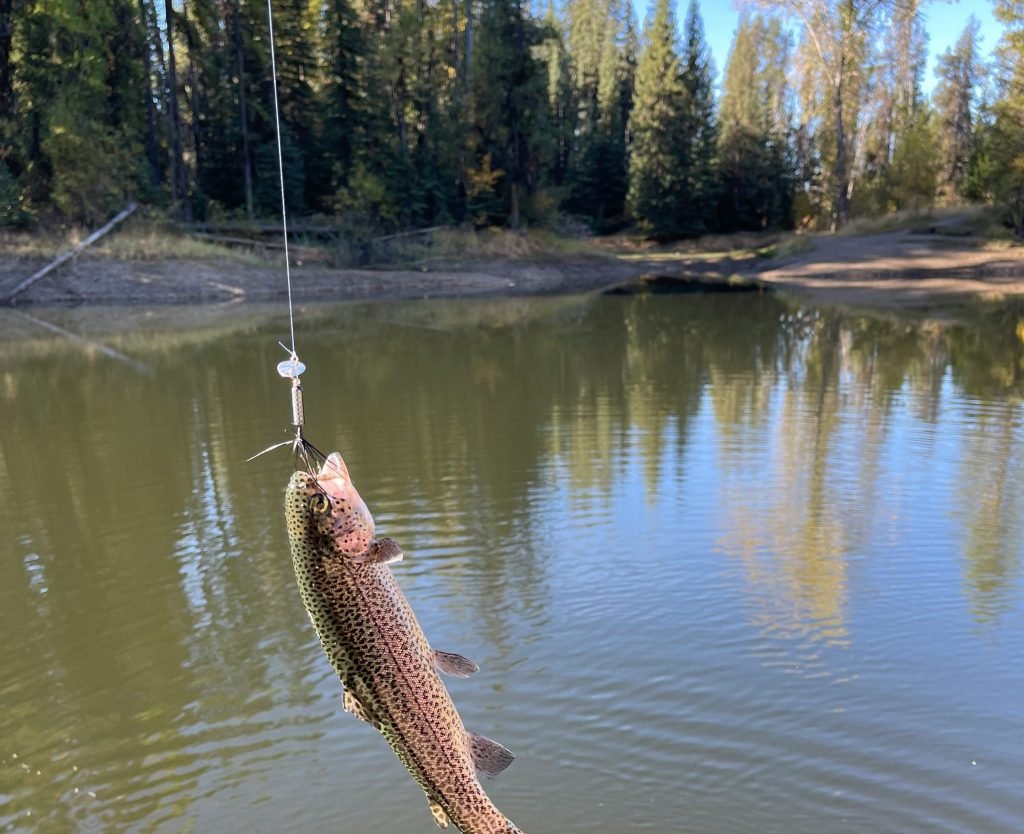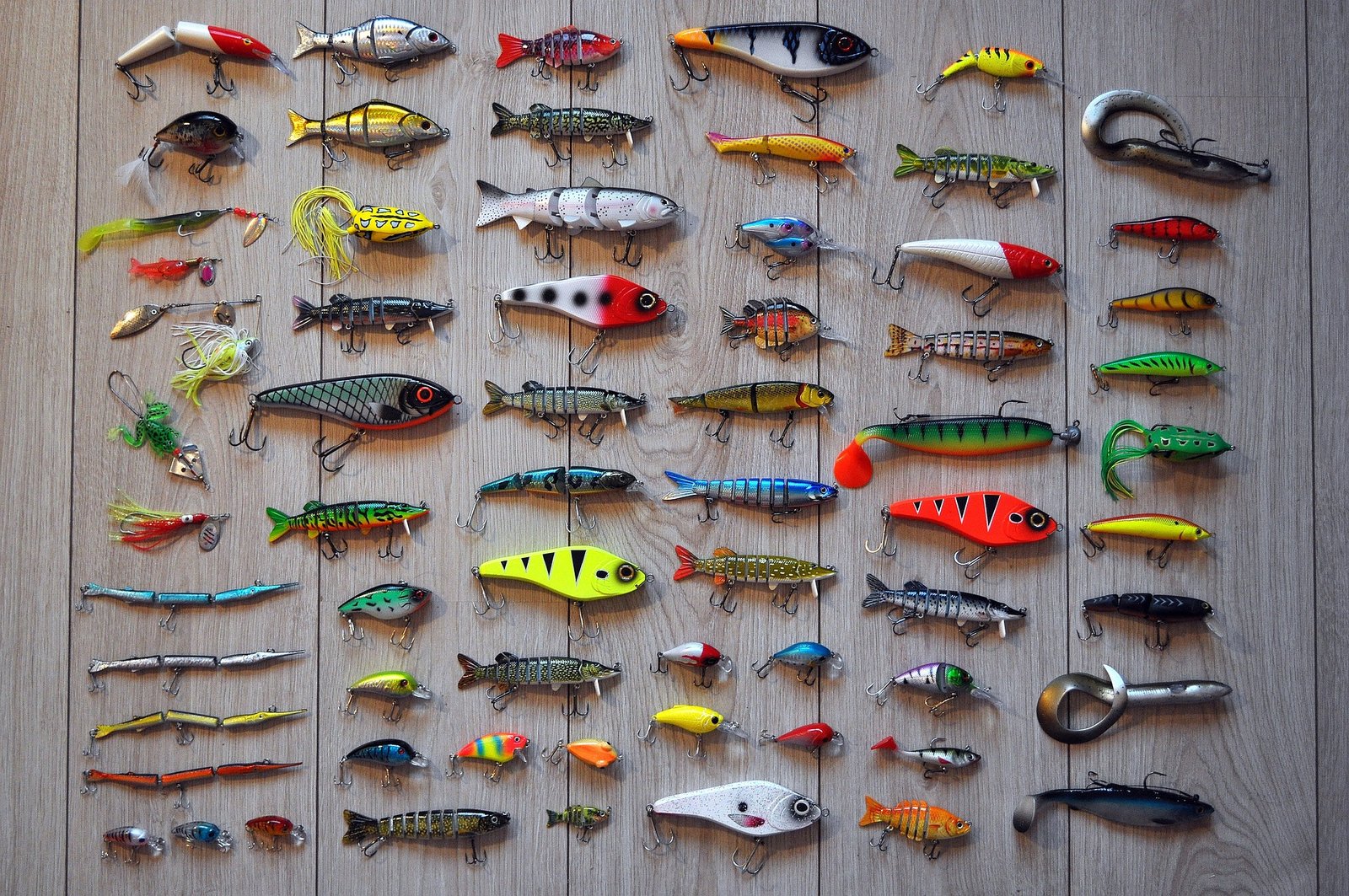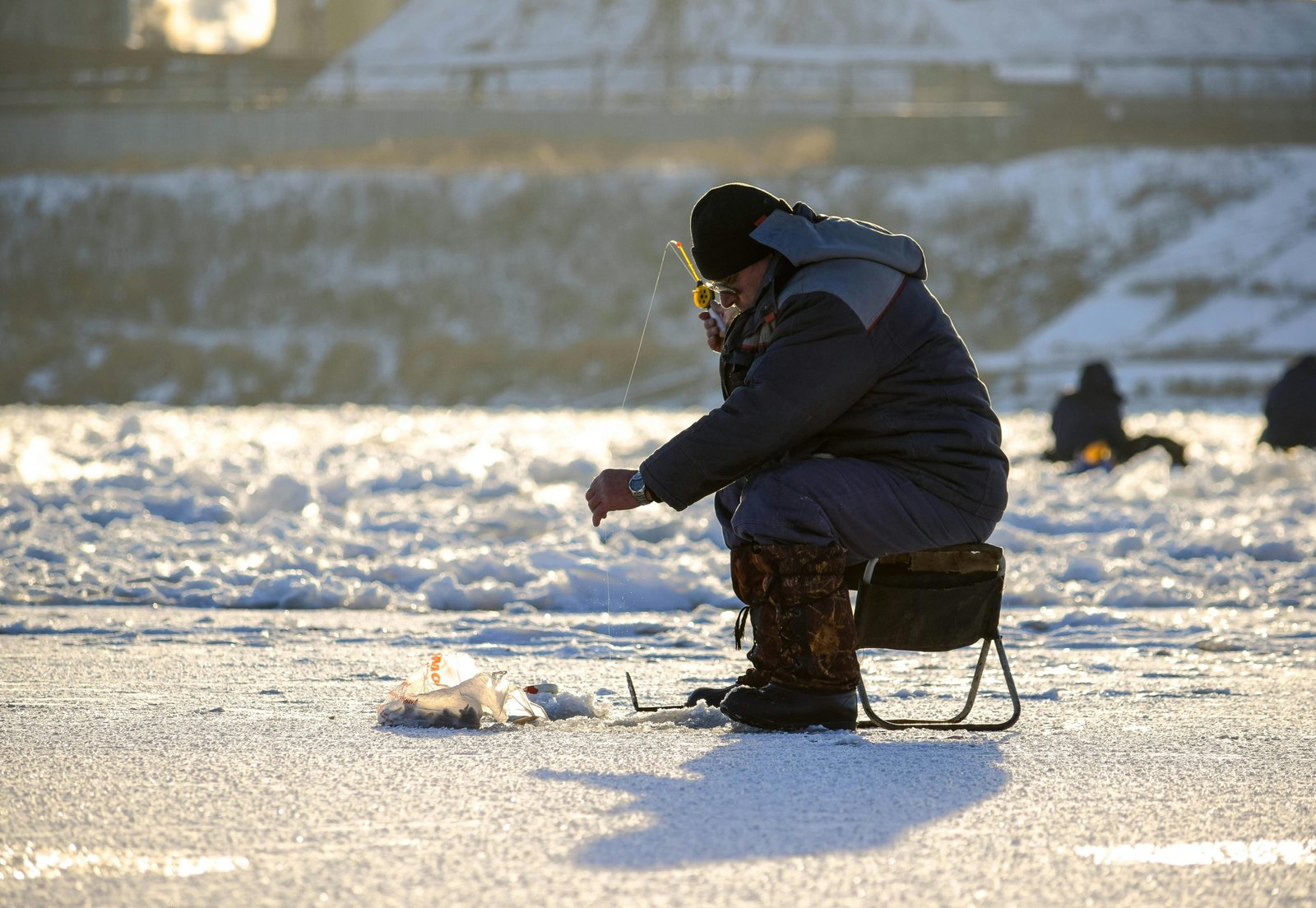
Trout can be notoriously picky eaters, so it’s important to choose a bait that will entice them to bite.
The most effective bait for trout still remains live bait, such as worms, grubs, and insects. Their movement and scent is unmatched in making trout bite.
But this doesn’t mean that artificial lures, such as spinners, spoons, and jigs won’t work.
These baits come in a variety of colors, sizes, and shapes, and can be used to imitate different types of prey.
I know that some of you don’t want to get your hands slimy and replace bait every few casts, so lures are a better option in this situation.
It all comes down to personal preference.
Without further ado, let’s see what’s best to use and discover some more about trout fishing.
Live Baits and Their Advantages

Live baits are a popular choice among anglers for catching trout. Here are some of the best live baits for trout fishing:
Worms
Earthworms are the most common live bait used for trout fishing. They are easy to find, affordable, and effective. Trout find them irresistible, and they can be used in various fishing techniques.
Use a small, single hook (size 8-12) to ensure the worm is presented naturally. Make sure the hook is covered completely to get the most out of them.
Minnows
Minnows are for the big trout. Use a larger hook than you would for worms, such as a size 4-8, depending on the size of the minnow.
Hook the minnow through the lips, back, or tail, taking care not to damage its vital organs if you want it to swim naturally.
You can either cast and retrieve the minnow slowly, allowing it to swim naturally, or you can use a float to suspend the minnow at a certain depth. Another method is to fish the minnow on the bottom using a sinker.
Insects
Grasshoppers, crickets, and maggots are all effective live baits for trout fishing. They are perfect for fly fishing, and trout can’t resist them.
If using live insects, hook them through the thorax or the abdomen. If using artificial flies, tie them onto the hook using any fly-tying technique.
Artificial Baits and When to Use Them
Lures are a popular choice for trout fishing and can be highly effective in the right conditions. Each type of lure works differently and appeals to trout in various ways:
- Spinners: Spinners work well for trout because they create vibration and flash as they move through the water, mimicking small fish.
))/424075.json)
- Technique: Cast the spinner out and retrieve it at a steady pace. The blade should spin consistently. Vary your retrieval speed and depth until you find what the trout are responding to.
- Options: The Mepps Aglia and Panther Martin spinners are two of the most popular and effective spinner brands.
- Pros: Spinners can cover a lot of water quickly and are easy to use.
- Cons: They can get snagged on underwater structures and are less effective in very clear and calm water where trout may be spooked by the flash.
- Spoons: Spoons wobble and reflect light as they move, which can trigger strikes from aggressive trout.
))/4889991.json)
- Technique: Similar to spinners, cast and retrieve the spoon, allowing it to wobble. You can also try jigging it up and down in the water.
- Options: The Acme Kastmaster and the Little Cleo are well-known spoons that perform consistently.
- Pros: Spoons can be cast long distances and are good for fishing deep water.
- Cons: They may not be as effective in shallow or very clear water where trout are wary.
- Jigs: Jigs can be very effective for trout, especially when they are fished close to the bottom.
))/3038987.json)
- Technique: Cast the jig and let it sink to the bottom. Then retrieve it with short, twitching motions to mimic an injured baitfish or other prey.
- Options: Trout Magnet jigs are a popular choice because they are specifically designed for trout and come in a variety of colors. This set comes with more jigs than you probably need.
- Pros: Jigs can be very effective in deeper water and during colder months.
- Cons: They require more skill to use effectively and can easily become snagged.
- Soft Worms: Soft plastic worms can be a good alternative to live worms, especially in areas with heavy fishing pressure.
))/2039245.json)
- Technique: Rig the soft worm on a hook with a weight and use it in the same way you would a live worm. The weight can be adjusted to keep the worm drifting near the bottom.
- Options: Berkley PowerBait Power Worms are known for their scent and flavor that attract trout.
- Pros: Soft worms can be more durable than live worms and can be infused with scents that attract trout. They can also be rigged in weedless configurations to reduce snags.
- Cons: They may not be as effective in very clear water where trout can distinguish them from live worms. Also, the lack of natural movement means you must impart action to the lure.
5. Plastic Mealworms and Waxworms: These imitations can be effective when trout are feeding on the real thing.
))/1982749.json)
- Technique: These can be fished on a small jig head or with a simple hook and split-shot rig. They should be presented in a way that mimics the natural movement of these insects in the water, usually with subtle twitches.
- Options: Berkley’s PowerBait and Gulp! lines offer realistic mealworm and waxworm imitations that are pre-scented to help attract fish.
- Pros: They are convenient, last longer than live bait, and can be very effective when trout are targeting specific insects.
- Cons: As with soft worms, the artificial versions may not be as effective in very clear water, and they require the angler to provide the action.
Trout Behavior

Trout are elusive species that require a thorough understanding of their behavior and feeding habits to catch. In this section, I will share insights on trout species and their habitats, feeding patterns, and diets.
Trout Species and Habitats
Trout are found in a variety of environments, including lakes, reservoirs, moving water, and still water. Each species of trout has its preferred habitat, which makes it easier to target them. For instance, brown trout prefer clear, cold water with a rocky bottom, while rainbow trout thrive in fast-moving water with plenty of oxygen.
Brook trout, on the other hand, prefer small streams and creeks with cold, clear water and a rocky bottom. Wild trout, which are native to specific regions, are more challenging to catch as they have adapted to their environment and are wary of anything that looks unnatural.
Feeding Patterns and Diet
Trout are visual hunters and rely on their keen eyesight to spot prey. Their diet varies depending on the environment they inhabit. Insects, crustaceans, and small fish are the primary food sources for trout. Therefore, it is essential to use bait that mimics their natural diet.
In moving water, trout tend to face upstream and wait for food to come to them. In still water, they tend to cruise along the edges of weed beds and drop-offs, looking for food. Knowing their feeding patterns and preferred diet can help you choose the right bait and increase your chances of catching them.
Choosing the Right Bait Colors
Now that you know what lures work best, you might be wondering which colors are the most appealing to trout. And this is exactly what I’ll cover in this section.
Color Selection for Different Environments
When fishing in clear water, it is best to use natural colors such as browns and olives. These colors blend in well with the surroundings and appear more natural to the trout.
Bright colors like pink and chartreuse work well in murky water or under overcast skies. These colors stand out more in low light conditions, making it easier for the trout to spot them.
Rainbow trout tend to be more attracted to bright colors, while brown trout prefer more natural colors. It is essential to keep this in mind when selecting your bait color.
Visibility and Attraction: What Trout See
Trout have excellent eyesight and can see colors in the same way that humans do. However, they have a different range of color perception, and some colors may appear more attractive to them than others.
Trout can see colors in the blue-green range of the spectrum, and they are particularly sensitive to shades of pink. This sensitivity is why pink-colored baits are so effective when fishing for trout.
When selecting bait colors, it is also important to consider the level of attraction. Some colors may be visible to the trout, but they may not be attracted to them. For example, bright colors like orange and red are visible to trout, but they may not be as attractive as other colors.
Conclusion and Further Resources

In this article, I have discussed some of the best baits for trout fishing. We have looked at different types of baits such as live bait, artificial lures, and natural baits. I have also discussed the factors that you should consider when selecting the best bait for trout fishing, including the type of water, the time of year, and the species of trout you are targeting.
Based on the research and reviews, I found that live bait such as worms, minnows, and salmon eggs are some of the best baits for trout fishing. These baits are readily available and easy to use.
However, I also found that artificial lures such as spinners, spoons, and jigs can also be effective in catching trout, especially in clear water.
In addition, you can also check out some classic books on trout fishing such as “Trout Fishing in America” by Richard Brautigan and “The Complete Book of Trout Fishing” by Ernie Schwiebert. These books provide valuable insights into trout fishing and can help you improve your skills.
Frequently Asked Questions
What type of Powerbait is most effective for catching trout?
When it comes to Powerbait, the most effective type for catching trout is the one that imitates the natural food source of the trout in the area you are fishing. For example, if the trout in your area primarily feed on insects, then a Powerbait that imitates an insect would be most effective. I recommend doing some research on the trout in your area and their feeding habits to determine the best type of Powerbait to use.
Which lures should be used to maximize success with rainbow trout in rivers?
When fishing for rainbow trout in rivers, it’s best to use lures that imitate the natural food source of the trout in that specific river. Some effective lures for rainbow trout in rivers include spinners, spoons, and small crankbaits. It’s important to vary your retrieval speed and technique to find what works best for the trout in the specific river you are fishing.
What are the preferred baits for targeting trout in lakes?
When targeting trout in lakes, some preferred baits include Powerbait, nightcrawlers, and small minnows. It’s important to vary your bait presentation and location to determine what works best for the trout in the specific lake you are fishing.
How does one choose the best bait for trout fishing in streams?
When choosing the best bait for trout fishing in streams, it’s important to consider the water conditions and the natural food source of the trout in that specific stream. Some effective baits for trout fishing in streams include worms, small spinners, and small crankbaits. It’s important to vary your bait presentation and location to determine what works best for the trout in the specific stream you are fishing.
What live baits are known to be most successful for trout fishing?
Live baits such as nightcrawlers, small minnows, and mealworms are known to be most successful for trout fishing. It’s important to vary your bait presentation and location to determine what works best for the trout in the specific body of water you are fishing.
Which colors are most likely to attract trout when fishing?
Research has shown that trout often respond well to baits in brighter shades like chartreuse, orange, or even white, especially in clearer waters. However, it’s important to vary your bait color and presentation to determine what works best for the trout in the specific body of water you are fishing.
As an Amazon Associates member, I might earn a commission when you buy through the links on this page, at no additional cost to you. Thanks for helping me do what I like.




